Prevention of supercritical carbon dioxide fluid extract from Chrysanthemum indicum Linnén on cutaneous squamous cell carcinomas progression following UV irradiation in mice
- Authors:
- Qi-Hong Luo
- Hong-Juan Chen
- Qing-Yuan Zhong
- Hao-En He
- Ying-Qi Huang
- You-Chen Liu
- Bin Lan
- Yao-Qi Wen
- Si-Liang Deng
- Xian-Hua Du
- Bao-Qin Lin
- Ya-Xian Zhan
-
Affiliations: School of Pharmaceutical Sciences, Guangzhou University of Chinese Medicine, Guangzhou, Guangdong 510006, P.R. China, Department of Pharmacy, The First Affiliated Hospital, Sun Yat‑sen University, Guangzhou, Guangdong 510080, P.R. China, Experimental Center, The First Affiliated Hospital of Guangzhou University of Chinese Medicine, Guangzhou, Guangdong 510405, P.R. China - Published online on: June 20, 2024 https://doi.org/10.3892/etm.2024.12619
- Article Number: 330
-
Copyright: © Luo et al. This is an open access article distributed under the terms of Creative Commons Attribution License.
This article is mentioned in:
Abstract
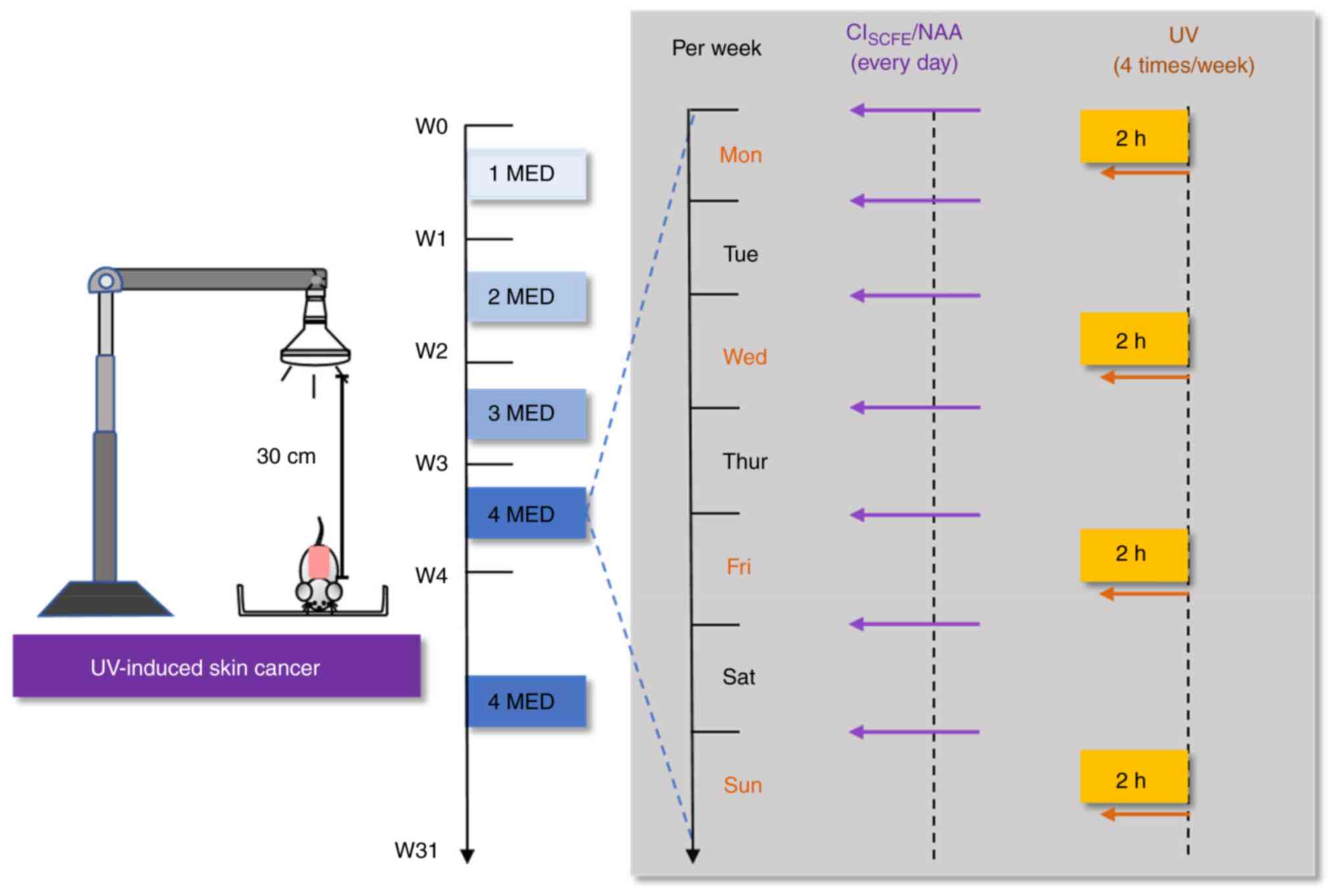 |
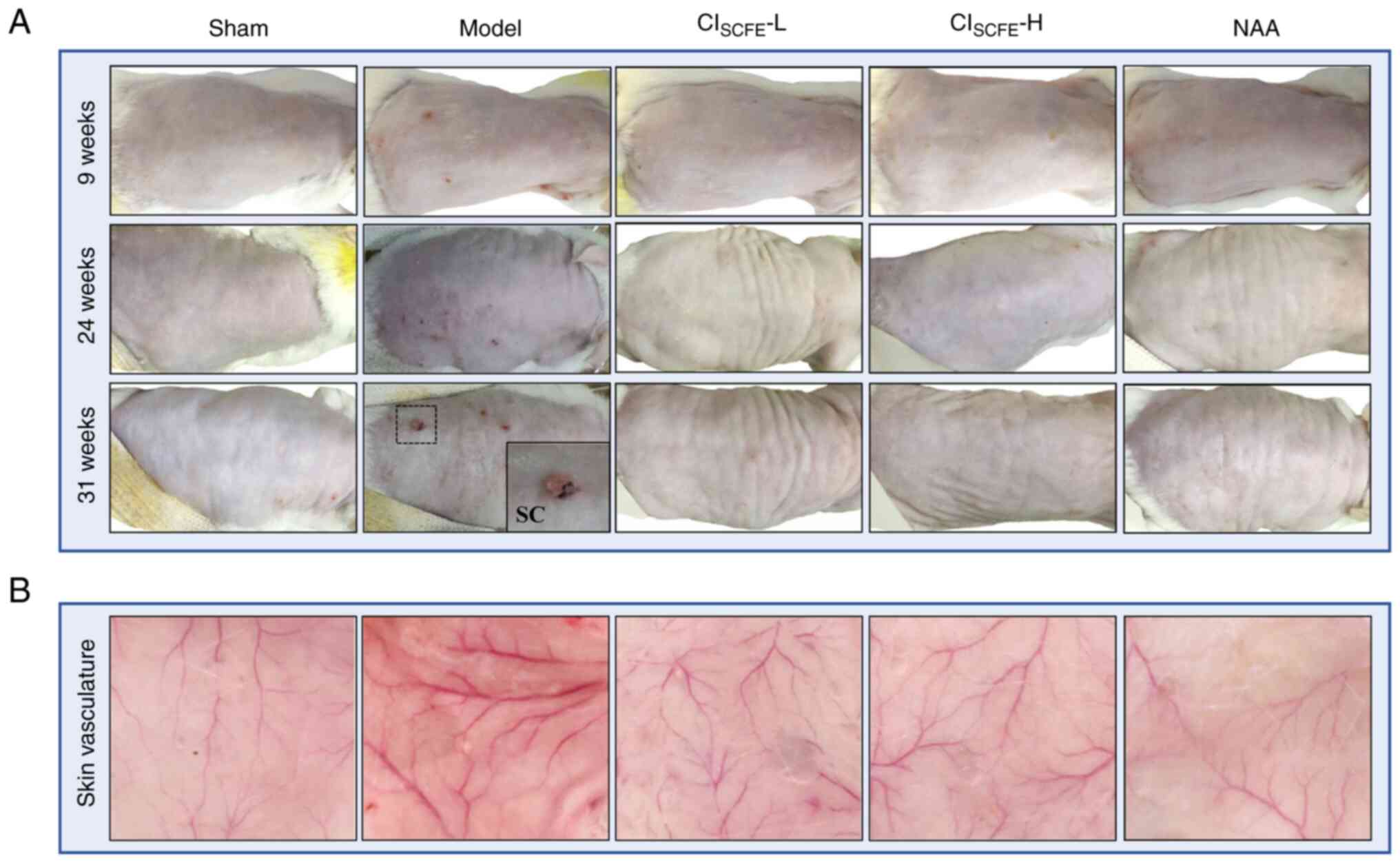 |
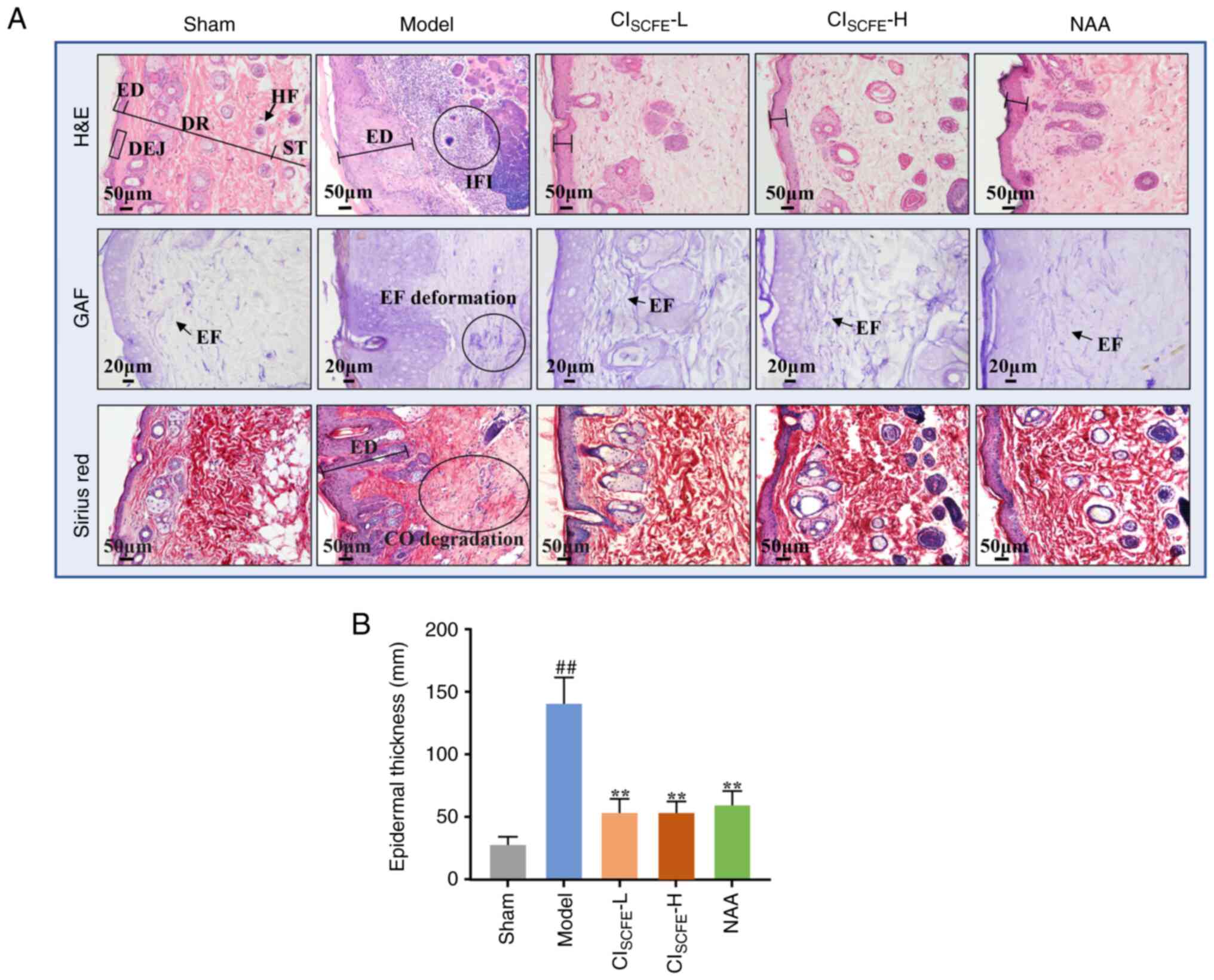 |
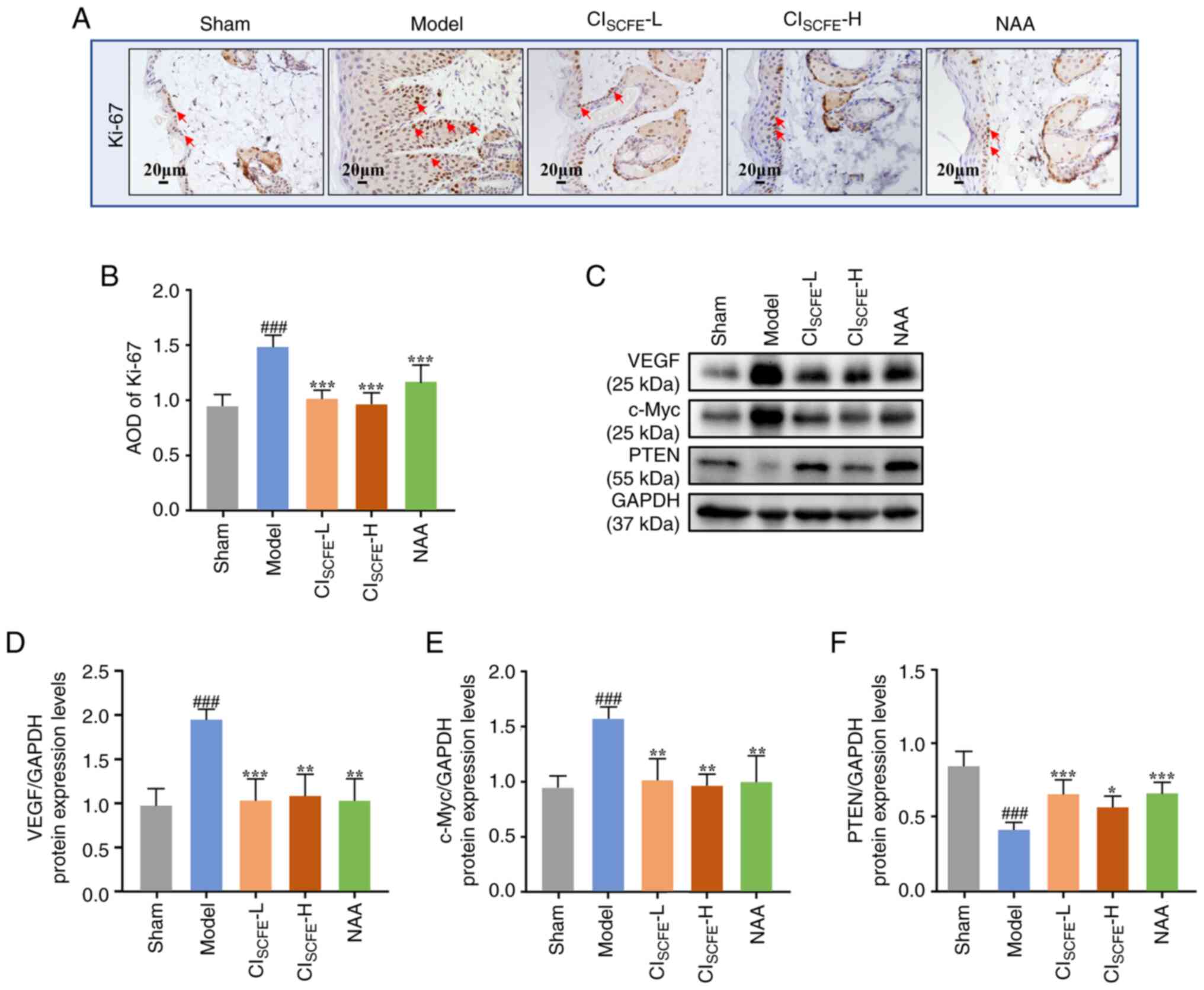 |
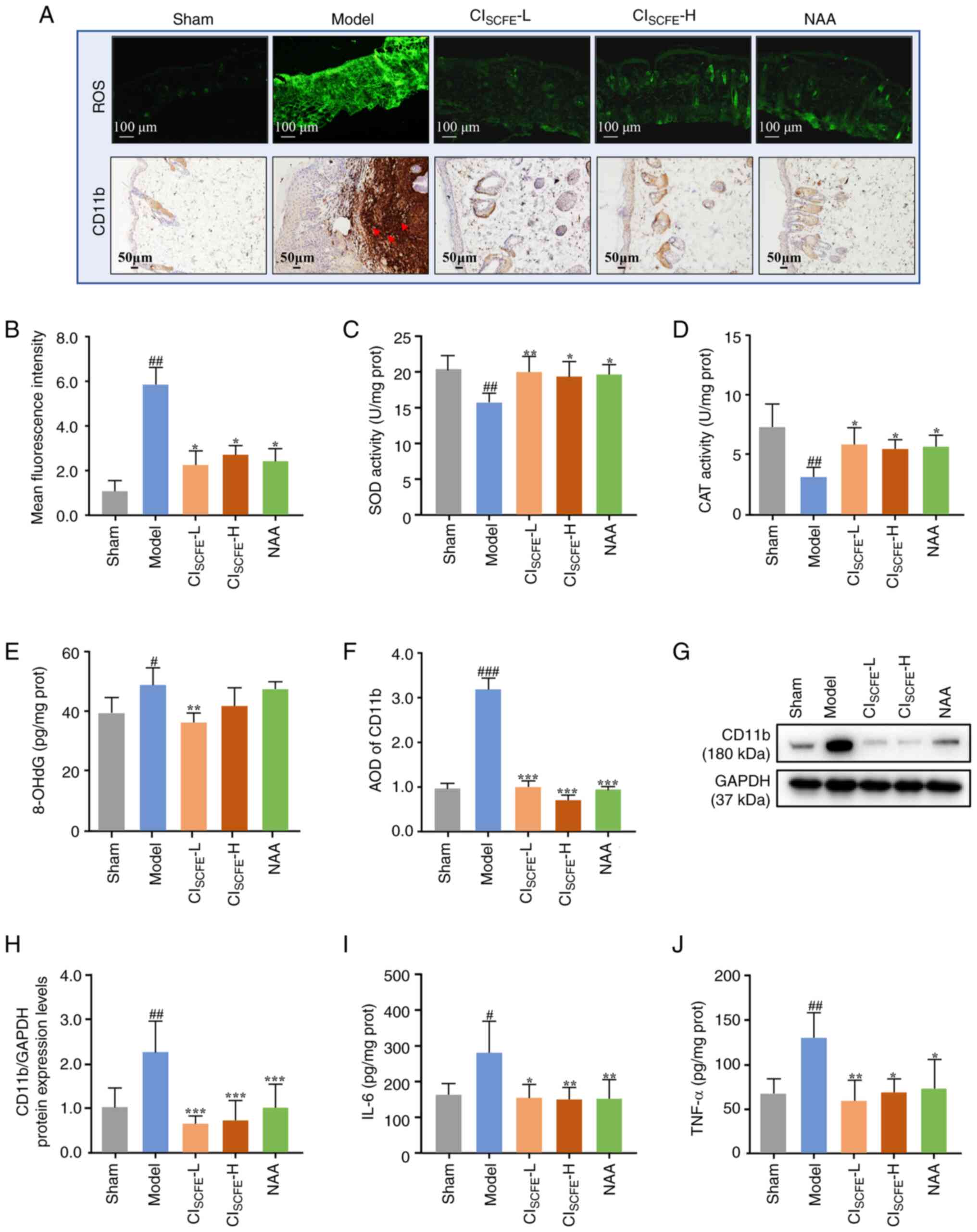 |
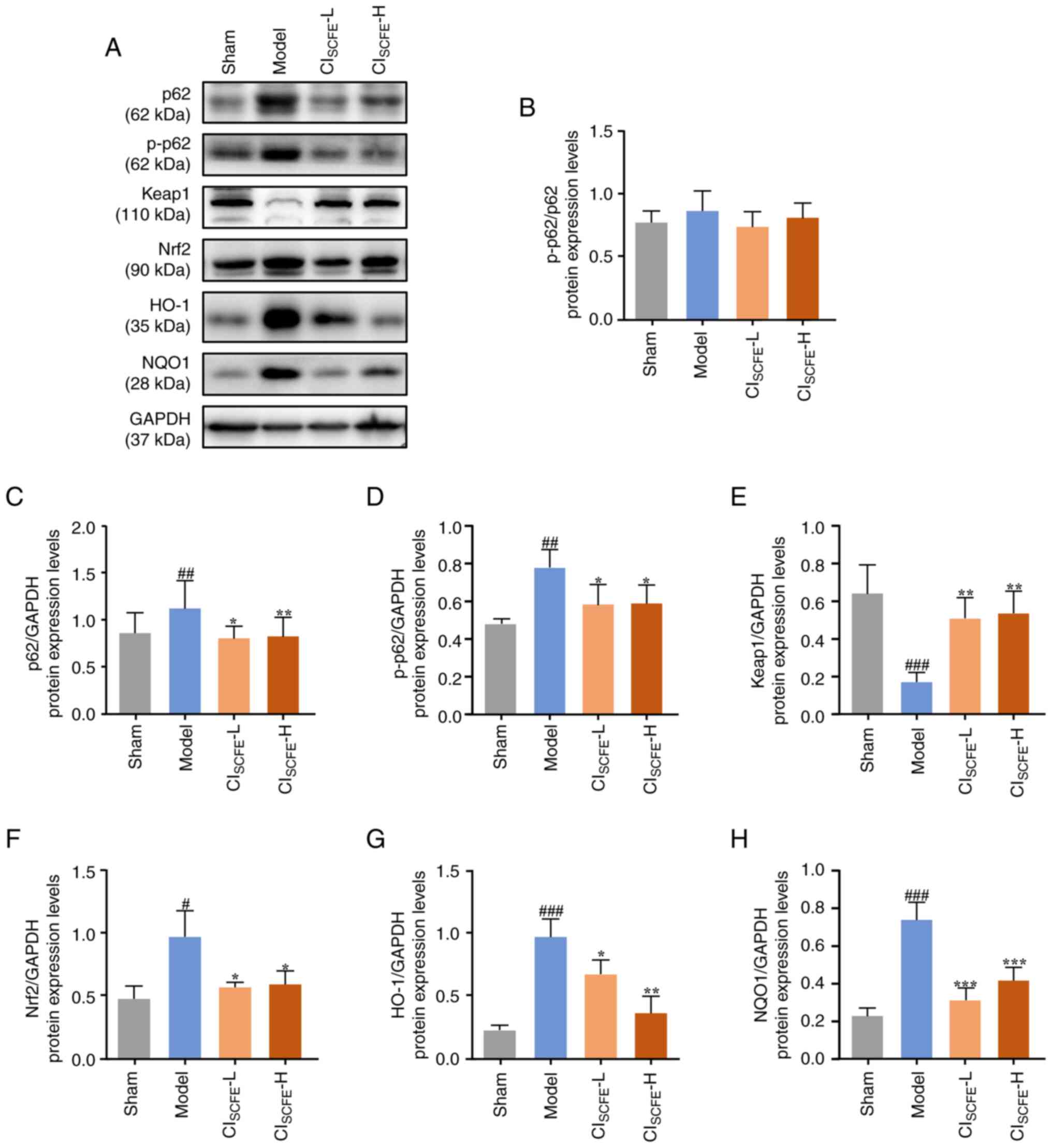 |
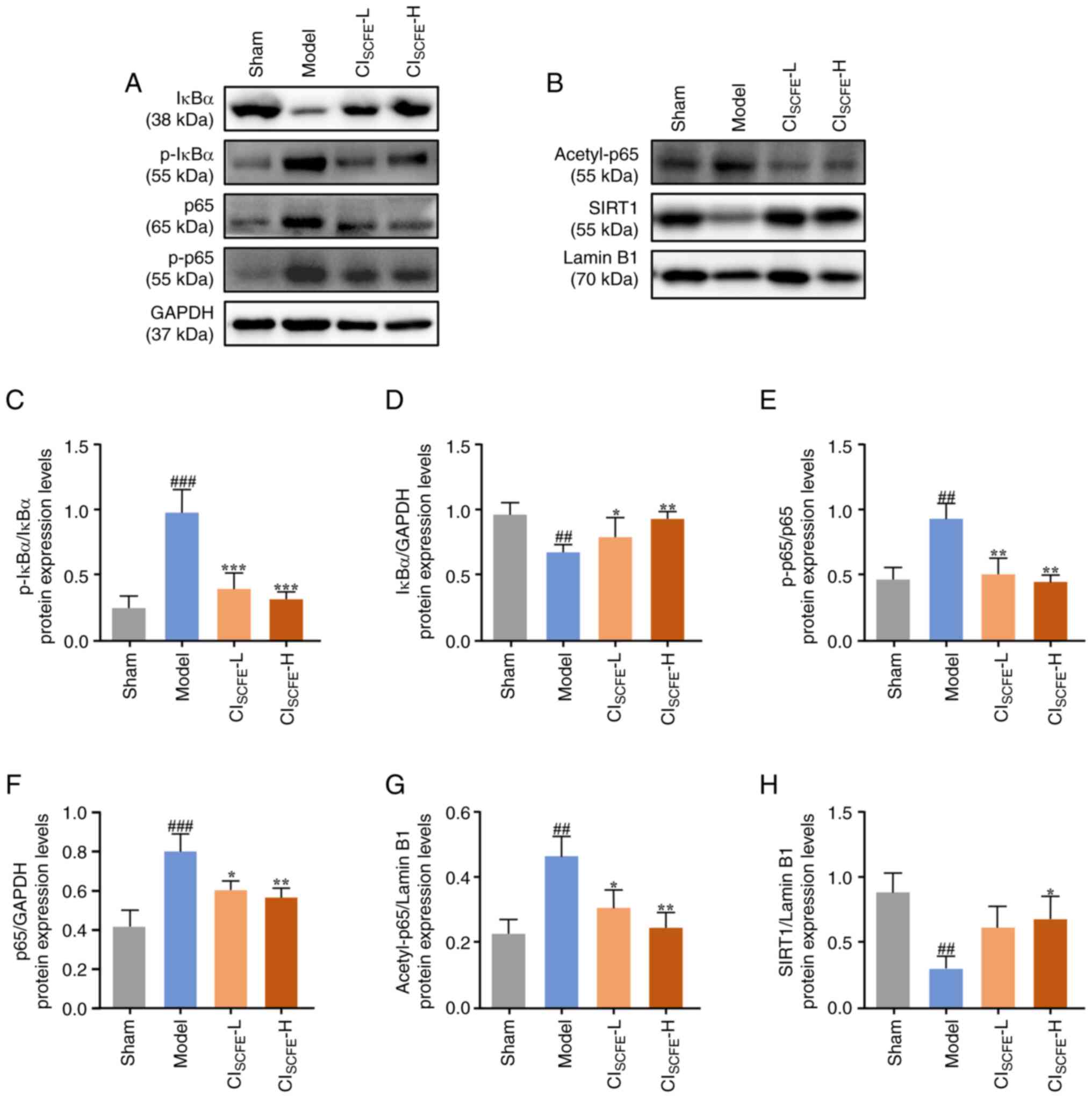 |
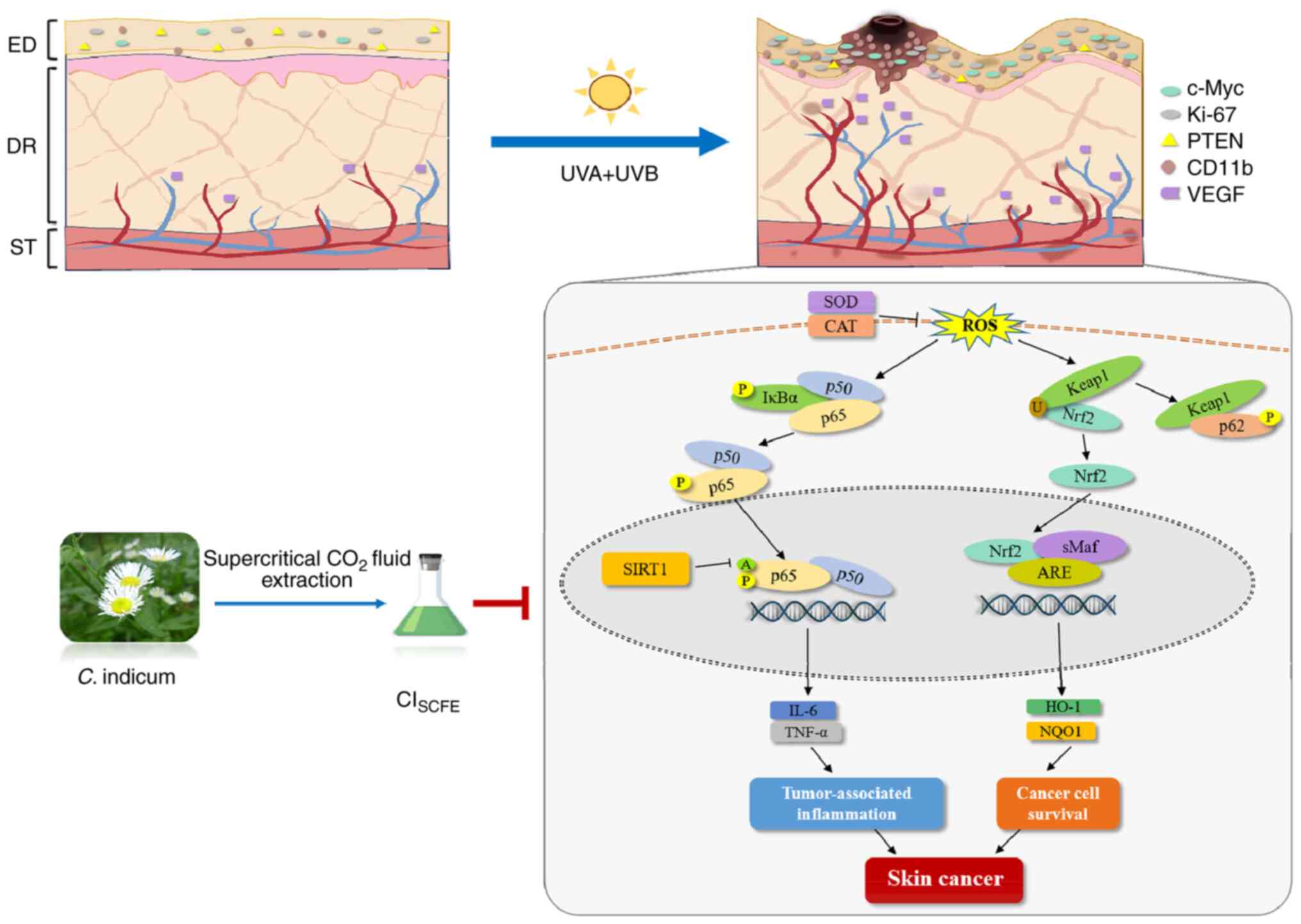 |
|
Sung H, Ferlay J, Siegel RL, Laversanne M, Soerjomataram I, Jemal A and Bray F: Global cancer statistics 2020: GLOBOCAN estimates of incidence and mortality worldwide for 36 cancers in 185 countries. CA Cancer J Clin. 71:209–249. 2021.PubMed/NCBI View Article : Google Scholar | |
|
Burton KA, Ashack KA and Khachemoune A: Cutaneous squamous cell carcinoma: A review of high-risk and metastatic disease. Am J Clin Dermatol. 17:491–508. 2016.PubMed/NCBI View Article : Google Scholar | |
|
Rogers HW, Weinstock MA, Feldman SR and Coldiron BM: Incidence estimate of nonmelanoma skin cancer (keratinocyte carcinomas) in the U.S. population, 2012. JAMA Dermatol. 151:1081–1086. 2015.PubMed/NCBI View Article : Google Scholar | |
|
Bachelor MA and Bowden GT: UVA-mediated activation of signaling pathways involved in skin tumor promotion and progression. Semin Cancer Biol. 14:131–138. 2004.PubMed/NCBI View Article : Google Scholar | |
|
Winge MCG, Kellman LN, Guo K, Tang JY, Swetter SM, Aasi SZ, Sarin KY, Chang ALS and Khavari PA: Advances in cutaneous squamous cell carcinoma. Nat Rev Cancer. 23:430–449. 2023.PubMed/NCBI View Article : Google Scholar | |
|
Forrester SJ, Kikuchi DS, Hernandes MS, Xu Q and Griendling KK: Reactive oxygen species in metabolic and inflammatory signaling. Circ Res. 122:877–902. 2018.PubMed/NCBI View Article : Google Scholar | |
|
Singh A, Kukreti R, Saso L and Kukreti S: Mechanistic insight into oxidative stress-triggered signaling pathways and type 2 diabetes. Molecules. 27(950)2022.PubMed/NCBI View Article : Google Scholar | |
|
Kim YE and Kim J: ROS-scavenging therapeutic hydrogels for modulation of the inflammatory response. ACS Appl Mater Interfaces: Dec 28, 2021 (Epub ahead of print). | |
|
Aggarwal V, Tuli HS, Varol A, Thakral F, Yerer MB, Sak K, Varol M, Jain A, Khan MA and Sethi G: Role of reactive oxygen species in cancer progression: molecular mechanisms and recent advancements. Biomolecules. 9(735)2019.PubMed/NCBI View Article : Google Scholar | |
|
Kawanishi S, Ohnishi S, Ma N, Hiraku Y and Murata M: Crosstalk between DNA damage and inflammation in the multiple steps of carcinogenesis. Int J Mol Sci. 18(1808)2017.PubMed/NCBI View Article : Google Scholar | |
|
Jomova K, Raptova R, Alomar SY, Alwasel SH, Nepovimova E, Kuca K and Valko M: Reactive oxygen species, toxicity, oxidative stress, and antioxidants: Chronic diseases and aging. Arch Toxicol. 97:2499–2574. 2023.PubMed/NCBI View Article : Google Scholar | |
|
Zhao Y, Ye X, Xiong Z, Ihsan A, Ares I, Martínez M, Lopez-Torres B, Martínez-Larrañaga MR, Anadón A, Wang X and Martínez MA: Cancer metabolism: the role of ROS in DNA damage and induction of apoptosis in cancer cells. Metabolites. 13(796)2023.PubMed/NCBI View Article : Google Scholar | |
|
Jaramillo MC and Zhang DD: The emerging role of the Nrf2-Keap1 signaling pathway in cancer. Genes Dev. 27:2179–2191. 2013.PubMed/NCBI View Article : Google Scholar | |
|
Kitamura H and Motohashi H: NRF2 addiction in cancer cells. Cancer Sci. 109:900–911. 2018.PubMed/NCBI View Article : Google Scholar | |
|
He F, Antonucci L and Karin M: NRF2 as a regulator of cell metabolism and inflammation in cancer. Carcinogenesis. 41:405–416. 2020.PubMed/NCBI View Article : Google Scholar | |
|
Ichimura Y, Waguri S, Sou YS, Kageyama S, Hasegawa J, Ishimura R, Saito T, Yang Y, Kouno T, Fukutomi T, et al: Phosphorylation of p62 activates the Keap1-Nrf2 pathway during selective autophagy. Mol Cell. 51:618–631. 2013.PubMed/NCBI View Article : Google Scholar | |
|
Singh V and Ubaid S: Role of silent information regulator 1 (SIRT1) in regulating oxidative stress and inflammation. Inflammation. 43:1589–1598. 2020.PubMed/NCBI View Article : Google Scholar | |
|
Jiang SB, Lu YS, Liu T, Li LM, Wang HX, Wu Y, Gao XH and Chen HD: UVA influenced the SIRT1-miR-27a-5p-SMAD2-MMP1/COL1/BCL2 axis in human skin primary fibroblasts. J Cell Mol Med. 24:10027–10041. 2020.PubMed/NCBI View Article : Google Scholar | |
|
Wu P, Zhang B, Han X, Sun Y, Sun Z, Li L, Zhou X, Jin Q, Fu P, Xu W and Qian H: HucMSC exosome-delivered 14-3-3ζ alleviates ultraviolet radiation-induced photodamage via SIRT1 pathway modulation. Aging. 13:11542–11563. 2021.PubMed/NCBI View Article : Google Scholar | |
|
Valente S, Mellini P, Spallotta F, Carafa V, Nebbioso A, Polletta L, Carnevale I, Saladini S, Trisciuoglio D, Gabellini C, et al: 1,4-Dihydropyridines active on the SIRT1/AMPK pathway ameliorate skin repair and mitochondrial function and exhibit inhibition of proliferation in cancer cells. J Med Chem. 59:1471–1491. 2016.PubMed/NCBI View Article : Google Scholar | |
|
Puppala ER, Yalamarthi SS, Aochenlar SL, Prasad N, Syamprasad NP, Singh M, Nanjappan SK, Ravichandiran V, Tripathi DM, Gangasani JK and Naidu VGM: Mesua assamica (King&Prain) kosterm. Bark ethanolic extract attenuates chronic restraint stress aggravated DSS-induced ulcerative colitis in mice via inhibition of NF-κB/STAT3 and activation of HO-1/Nrf2/SIRT1 signaling pathways. J Ethnopharmacol. 301(115765)2023.PubMed/NCBI View Article : Google Scholar | |
|
Zhang X, Wu JZ, Lin ZX, Yuan QJ, Li YC, Liang JL, Zhan JY, Xie YL, Su ZR and Liu YH: Ameliorative effect of supercritical fluid extract of Chrysanthemum indicum Linnén against D-galactose induced brain and liver injury in senescent mice via suppression of oxidative stress, inflammation and apoptosis. J Ethnopharmacol. 234:44–56. 2019.PubMed/NCBI View Article : Google Scholar | |
|
Shao Y, Sun Y, Li D and Chen Y: Chrysanthemum indicum L.: A comprehensive review of its botany, phytochemistry and pharmacology. Am J Chin Med. 48:871–897. 2020.PubMed/NCBI View Article : Google Scholar | |
|
Kim WJ, Yu HS, Bae WY, Ko KY, Chang KH, Lee NK and Paik HD: Chrysanthemum indicum suppresses adipogenesis by inhibiting mitotic clonal expansion in 3T3-L1 preadipocytes. J Food Biochem. 45(e13896)2021.PubMed/NCBI View Article : Google Scholar | |
|
Yang X, Liu Y, Zhong C, Hu J, Xu S, Zhang P and He L: Total flavonoids of Chrysanthemum indicum L inhibit acute pancreatitis through suppressing apoptosis and inflammation. BMC Complement Med Ther. 23(23)2023.PubMed/NCBI View Article : Google Scholar | |
|
Wu XL, Li CW, Chen HM, Su ZQ, Zhao XN, Chen JN, Lai XP, Zhang XJ and Su ZR: Anti-inflammatory effect of supercritical-carbon dioxide fluid extract from flowers and buds of Chrysanthemum indicum Linnen. Evid Based Complement Alternat Med. 2013(413237)2013.PubMed/NCBI View Article : Google Scholar | |
|
Yang HM, Sun CY, Liang JL, Xu LQ, Zhang ZB, Luo DD, Chen HB, Huang YZ, Wang Q, Lee DY, et al: Supercritical-carbon dioxide fluid extract from Chrysanthemum indicum enhances anti-tumor effect and reduces toxicity of bleomycin in tumor-bearing mice. Int J Mol Sci. 18(465)2017.PubMed/NCBI View Article : Google Scholar | |
|
Zhang X, Xie YL, Yu XT, Su ZQ, Yuan J, Li YC, Su ZR, Zhan JY and Lai XP: Protective effect of super-critical carbon dioxide fluid extract from flowers and buds of Chrysanthemum indicum Linnén against ultraviolet-induced photo-aging in mice. Rejuvenation Res. 18:437–448. 2015.PubMed/NCBI View Article : Google Scholar | |
|
MacArthur Clark JA and Sun D: Guidelines for the ethical review of laboratory animal welfare people's republic of china national standard GB/T 35892-2018 [Issued 6 February 2018 Effective from 1 September 2018]. Animal Model Exp Med. 3:103–113. 2020.PubMed/NCBI View Article : Google Scholar | |
|
Pillon A, Gomes B, Vandenberghe I, Cartron V, Cèbe P, Blanchet JC, Sibaud V, Guilbaud N, Audoly L, Lamant L and Kruczynski A: Actinic keratosis modelling in mice: A translational study. PLoS One. 12(e0179991)2017.PubMed/NCBI View Article : Google Scholar | |
|
Zhong QY, Lin B, Chen YT, Huang YP, Feng WP, Wu Y, Long GH, Zou YN, Liu Y, Lin BQ, et al: Gender differences in UV-induced skin inflammation, skin carcinogenesis and systemic damage. Environ Toxicol Pharmacol. 81(103512)2021.PubMed/NCBI View Article : Google Scholar | |
|
Wang Y, Zhao Z, Jiao W, Yin Z, Zhao W, Bo H, Bi Z, Dong B, Chen B and Wang Z: PRAF2 is an oncogene acting to promote the proliferation and invasion of breast cancer cells. Exp Ther Med. 24(738)2022.PubMed/NCBI View Article : Google Scholar | |
|
Que SKT, Zwald FO and Schmults CD: Cutaneous squamous cell carcinoma: Incidence, risk factors, diagnosis, and staging. J Am Acad Dermatol. 78:237–247. 2018.PubMed/NCBI View Article : Google Scholar | |
|
Sun S, Jiang P, Su W, Xiang Y, Li J, Zeng L and Yang S: Wild chrysanthemum extract prevents UVB radiation-induced acute cell death and photoaging. Cytotechnology. 68:229–240. 2016.PubMed/NCBI View Article : Google Scholar | |
|
Allen NC, Martin AJ, Snaidr VA, Eggins R, Chong AH, Fernandéz-Peñas P, Gin D, Sidhu S, Paddon VL, Banney LA, et al: Nicotinamide for skin-cancer chemoprevention in transplant recipients. N Engl J Med. 388:804–812. 2023.PubMed/NCBI View Article : Google Scholar | |
|
Snaidr VA, Damian DL and Halliday GM: Nicotinamide for photoprotection and skin cancer chemoprevention: A review of efficacy and safety. Exp Dermatol. 28 (Suppl 1):S15–S22. 2019.PubMed/NCBI View Article : Google Scholar | |
|
Damian DL: Nicotinamide for skin cancer chemoprevention. Australas J Dermatol. 58:174–180. 2017.PubMed/NCBI View Article : Google Scholar | |
|
Stratigos A, Garbe C, Lebbe C, Malvehy J, del Marmol V, Pehamberger H, Peris K, Becker JC, Zalaudek I, Saiag P, et al: Diagnosis and treatment of invasive squamous cell carcinoma of the skin: European consensus-based interdisciplinary guideline. Eur J Cancer. 51:1989–2007. 2015.PubMed/NCBI View Article : Google Scholar | |
|
Stratigos AJ, Garbe C, Dessinioti C, Lebbe C, Bataille V, Bastholt L, Dreno B, Fargnoli MC, Forsea AM, Frenard C, et al: European interdisciplinary guideline on invasive squamous cell carcinoma of the skin: Part 1. Epidemiology, diagnostics and prevention. Eur J Cancer. 128:60–82. 2020.PubMed/NCBI View Article : Google Scholar | |
|
Dorrell DN and Strowd LC: Skin cancer detection technology. Dermatol Clin. 37:527–536. 2019.PubMed/NCBI View Article : Google Scholar | |
|
Firnhaber JM: Basal cell and cutaneous squamous cell carcinomas: Diagnosis and treatment. Am Fam Physician. 102:339–346. 2020.PubMed/NCBI | |
|
Wang X, Liu Y, Niu Y, Wang N and Gu W: The chemical composition and functional properties of essential oils from four species of Schisandra growing wild in the qinling mountains, China. Molecules. 23(1645)2018.PubMed/NCBI View Article : Google Scholar | |
|
Rahaman A, Chaudhuri A, Sarkar A, Chakraborty S, Bhattacharjee S and Mandal DP: Eucalyptol targets PI3K/Akt/mTOR pathway to inhibit skin cancer metastasis. Carcinogenesis. 43:571–583. 2022.PubMed/NCBI View Article : Google Scholar | |
|
Rawat A, Rawat M, Prakash OM, Kumar R, Punetha H and Rawat DS: Comparative study on eucalyptol and camphor rich essential oils from rhizomes of Hedychium spicatum Sm. and their pharmacological, antioxidant and antifungal activities. An Acad Bras Cienc. 94(e20210932)2022.PubMed/NCBI View Article : Google Scholar | |
|
Li Y, Wen JM, Du CJ, Hu SM, Chen JX, Zhang SG, Zhang N, Gao F, Li SJ, Mao XW, et al: Thymol inhibits bladder cancer cell proliferation via inducing cell cycle arrest and apoptosis. Biochem Biophys Res Commun. 491:530–536. 2017.PubMed/NCBI View Article : Google Scholar | |
|
Xiu Z, Zhu Y, Han J, Li Y, Yang X, Yang G, Song G, Li S, Li Y, Cheng C, et al: Caryophyllene oxide induces ferritinophagy by regulating the NCOA4/FTH1/LC3 pathway in hepatocellular carcinoma. Front Pharmacol. 13(930958)2022.PubMed/NCBI View Article : Google Scholar | |
|
Zhen ZG, Ren SH, Ji HM, Ma JH, Ding XM, Feng FQ, Chen SL, Zou P, Ren JR and Jia L: Linarin suppresses glioma through inhibition of NF-κB/p65 and up-regulating p53 expression in vitro and in vivo. Biomed Pharmacother. 95:363–374. 2017.PubMed/NCBI View Article : Google Scholar | |
|
Wang L, Du H and Chen P: Chlorogenic acid inhibits the proliferation of human lung cancer A549 cell lines by targeting annexin A2 in vitro and in vivo. Biomed Pharmacother. 131(110673)2020.PubMed/NCBI View Article : Google Scholar | |
|
Velmurugan BK, Lin JT, Mahalakshmi B, Chuang YC, Lin CC, Lo YS, Hsieh MJ and Chen MK: Luteolin-7-O-glucoside inhibits oral cancer cell migration and invasion by regulating matrix metalloproteinase-2 expression and extracellular signal-regulated kinase pathway. Biomolecules. 10(502)2020.PubMed/NCBI View Article : Google Scholar | |
|
Singh S, Gupta P, Meena A and Luqman S: Acacetin, a flavone with diverse therapeutic potential in cancer, inflammation, infections and other metabolic disorders. Food Chem Toxicol. 145(111708)2020.PubMed/NCBI View Article : Google Scholar | |
|
Weinstein IB and Joe A: Oncogene addiction. Cancer Res. 68:3077–3080. 2008.PubMed/NCBI View Article : Google Scholar | |
|
Wu H, Yang TY, Li Y, Ye WL, Liu F, He XS, Wang JR, Gan WJ, Li XM, Zhang S, et al: Tumor necrosis factor receptor-associated factor 6 promotes hepatocarcinogenesis by interacting with histone deacetylase 3 to enhance c-Myc gene expression and protein stability. Hepatology. 71:148–163. 2020.PubMed/NCBI View Article : Google Scholar | |
|
Pelengaris S, Littlewood T, Khan M, Elia G and Evan G: Reversible activation of c-Myc in skin: Induction of a complex neoplastic phenotype by a single oncogenic lesion. Mol Cell. 3:565–577. 1999.PubMed/NCBI View Article : Google Scholar | |
|
Menon SS, Guruvayoorappan C, Sakthivel KM and Rasmi RR: Ki-67 protein as a tumour proliferation marker. Clin Chim Acta. 491:39–45. 2019.PubMed/NCBI View Article : Google Scholar | |
|
Viallard C and Larrivée B: Tumor angiogenesis and vascular normalization: Alternative therapeutic targets. Angiogenesis. 20:409–426. 2017.PubMed/NCBI View Article : Google Scholar | |
|
Carmeliet P: VEGF as a key mediator of angiogenesis in cancer. Oncology. 69 (Suppl 3):S4–S10. 2005.PubMed/NCBI View Article : Google Scholar | |
|
Álvarez-Garcia V, Tawil Y, Wise HM and Leslie NR: Mechanisms of PTEN loss in cancer: It's all about diversity. Semin Cancer Biol. 59:66–79. 2019.PubMed/NCBI View Article : Google Scholar | |
|
Wang Y, Digiovanna JJ, Stern JB, Hornyak TJ, Raffeld M, Khan SG, Oh KS, Hollander MC, Dennis PA and Kraemer KH: Evidence of ultraviolet type mutations in xeroderma pigmentosum melanomas. Proc Natl Acad Sci USA. 106:6279–6284. 2009.PubMed/NCBI View Article : Google Scholar | |
|
Garg C, Sharma H and Garg M: Skin photo-protection with phytochemicals against photo-oxidative stress, photo-carcinogenesis, signal transduction pathways and extracellular matrix remodeling-An overview. Ageing Res Rev. 62(101127)2020.PubMed/NCBI View Article : Google Scholar | |
|
Al-Sadek T and Yusuf N: Ultraviolet radiation biological and medical implications. Curr Issues Mol Biol. 46:1924–1942. 2024.PubMed/NCBI View Article : Google Scholar | |
|
Jelic MD, Mandic AD, Maricic SM and Srdjenovic BU: Oxidative stress and its role in cancer. J Cancer Res Ther. 17:22–28. 2021.PubMed/NCBI View Article : Google Scholar | |
|
Murtas D, Piras F, Minerba L, Ugalde J, Floris C, Maxia C, Demurtas P, Perra MT and Sirigu P: Nuclear 8-hydroxy-2'-deoxyguanosine as survival biomarker in patients with cutaneous melanoma. Oncol Rep. 23:329–335. 2010.PubMed/NCBI | |
|
Cerutti P, Ghosh R, Oya Y and Amstad P: The role of the cellular antioxidant defense in oxidant carcinogenesis. Environ Health Perspect. 102 (Suppl 10):S123–S129. 1994.PubMed/NCBI View Article : Google Scholar | |
|
Sluyter R and Halliday GM: Infiltration by inflammatory cells required for solar-simulated ultraviolet radiation enhancement of skin tumor growth. Cancer Immunol Immunother. 50:151–156. 2001.PubMed/NCBI View Article : Google Scholar | |
|
Mittal A, Elmets CA and Katiyar SK: CD11b+ cells are the major source of oxidative stress in UV radiation-irradiated skin: possible role in photoaging and photocarcinogenesis. Photochem Photobiol. 77:259–264. 2003.PubMed/NCBI View Article : Google Scholar | |
|
Katiyar SK, Meleth S and Sharma SD: Silymarin, a flavonoid from milk thistle (Silybum marianum L.), inhibits UV-induced oxidative stress through targeting infiltrating CD11b+ cells in mouse skin. Photochem Photobiol. 84:266–271. 2008.PubMed/NCBI View Article : Google Scholar | |
|
Su H, Yang F, Fu R, Li X, French R, Mose E, Pu X, Trinh B, Kumar A, Liu J, et al: Cancer cells escape autophagy inhibition via NRF2-induced macropinocytosis. Cancer Cell. 39:678–693.e11. 2021.PubMed/NCBI View Article : Google Scholar | |
|
Kim YR, Oh JE, Kim MS, Kang MR, Park SW, Han JY, Eom HS, Yoo NJ and Lee SH: Oncogenic NRF2 mutations in squamous cell carcinomas of oesophagus and skin. J Pathol. 220:446–451. 2010.PubMed/NCBI View Article : Google Scholar | |
|
Jiang T, Harder B, Rojo de la Vega M, Wong PK, Chapman E and Zhang DD: p62 links autophagy and Nrf2 signaling. Free Radic Biol Med. 88:199–204. 2015.PubMed/NCBI View Article : Google Scholar | |
|
Lee DH, Park JS, Lee YS, Han J, Lee DK, Kwon SW, Han DH, Lee YH and Bae SH: SQSTM1/p62 activates NFE2L2/NRF2 via ULK1-mediated autophagic KEAP1 degradation and protects mouse liver from lipotoxicity. Autophagy. 16:1949–1973. 2020.PubMed/NCBI View Article : Google Scholar | |
|
Inoue J, Gohda J, Akiyama T and Semba K: NF-kappaB activation in development and progression of cancer. Cancer Sci. 98:268–274. 2007.PubMed/NCBI View Article : Google Scholar | |
|
Bellezza I, Giambanco I, Minelli A and Donato R: Nrf2-Keap1 signaling in oxidative and reductive stress. Biochim Biophys Acta Mol Cell Res. 1865:721–733. 2018.PubMed/NCBI View Article : Google Scholar | |
|
Li CX, Gao JG, Wan XY, Chen Y, Xu CF, Feng ZM, Zeng H, Lin YM, Ma H, Xu P, et al: Allyl isothiocyanate ameliorates lipid accumulation and inflammation in nonalcoholic fatty liver disease via the Sirt1/AMPK and NF-κB signaling pathways. World J Gastroenterol. 25:5120–5133. 2019.PubMed/NCBI View Article : Google Scholar | |
|
Chen M, Chen Z, Huang D, Sun C, Xie J, Chen T, Zhao X, Huang Y, Li D, Wu B and Wu D: Myricetin inhibits TNF-α-induced inflammation in A549 cells via the SIRT1/NF-κB pathway. Pulm Pharmacol Ther. 65(102000)2020.PubMed/NCBI View Article : Google Scholar | |
|
Sun HJ, Xiong SP, Cao X, Cao L, Zhu MY, Wu ZY and Bian JS: Polysulfide-mediated sulfhydration of SIRT1 prevents diabetic nephropathy by suppressing phosphorylation and acetylation of p65 NF-κB and STAT3. Redox Biol. 38(101813)2021.PubMed/NCBI View Article : Google Scholar | |
|
Ming M, Shea CR, Guo X, Li X, Soltani K, Han W and He YY: Regulation of global genome nucleotide excision repair by SIRT1 through xeroderma pigmentosum C. Proc Natl Acad Sci USA. 107:22623–22628. 2010.PubMed/NCBI View Article : Google Scholar | |
|
Scott NR, Swanson RV, Al-Hammadi N, Domingo-Gonzalez R, Rangel-Moreno J, Kriel BA, Bucsan AN, Das S, Ahmed M, Mehra S, et al: S100A8/A9 regulates CD11b expression and neutrophil recruitment during chronic tuberculosis. J Clin Invest. 130:3098–3112. 2020.PubMed/NCBI View Article : Google Scholar | |
|
Crinier A, Narni-Mancinelli E, Ugolini S and Vivier E: SnapShot: Natural killer cells. Cell. 180:1280–1280.e1. 2020.PubMed/NCBI View Article : Google Scholar | |
|
Subhi Y, Krogh Nielsen M, Molbech CR, Krüger Falk M, Singh A, Hviid TVF, Nissen MH and Sørensen TL: Association of CD11b+ monocytes and anti-vascular endothelial growth factor injections in treatment of neovascular age-related macular degeneration and polypoidal choroidal vasculopathy. JAMA Ophthalmol. 137:515–522. 2019.PubMed/NCBI View Article : Google Scholar | |
|
Rombouts M, Ammi R, Van Brussel I, Roth L, De Winter BY, Vercauteren SR, Hendriks JM, Lauwers P, Van Schil PE, De Meyer GR, et al: Linking CD11b (+) dendritic cells and natural killer T cells to plaque inflammation in atherosclerosis. Mediators Inflamm. 2016(6467375)2016.PubMed/NCBI View Article : Google Scholar | |
|
Sluyter R and Halliday GM: Enhanced tumor growth in UV-irradiated skin is associated with an influx of inflammatory cells into the epidermis. Carcinogenesis. 21:1801–1807. 2000.PubMed/NCBI View Article : Google Scholar | |
|
Scibiorek M, Mthembu N, Mangali S, Ngomti A, Ikwegbue P, Brombacher F and Hadebe S: IL-4Rα signalling in B cells and T cells play differential roles in acute and chronic atopic dermatitis. Sci Rep. 13(144)2023.PubMed/NCBI View Article : Google Scholar |









